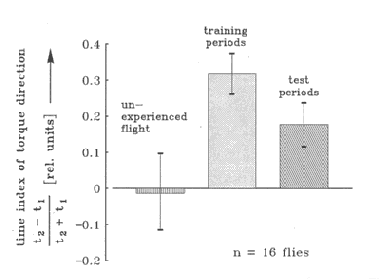Yaw Torque Learning
(Yaw torque can operate a heat source)
In the Drosophila flight simulator, the tethered fly is heated by an infrared lightsource whenever the fly's yaw torque is in one half of its range. The heat is switched off as soon as the torque passes into the other half. In this paradigm, the fly has no external stimuli that might serve as predictors of reinforcement. The arena is still illuminated from behind, but there are no patterns attached to it. This situation is totally unrealistic for the fly: one half of the yaw torque range (approximately corresponding to either left or right turns) is coupled to the heat source. There is no place one could think of where, say, right turns keep the fly away from a heat source and right turns constantly lead to life threatening heat. Neither do the fly's senses provide any information other than about its own behavior. Nevertheless, whithout extensive training, Drosophila keeps its yaw torque in the 'safe' range. So the central nervous system of the fly has to compare the temporal pattern of the thermoreceptor signals with efference copies of all or many of its motor-outputs. Any significant coincidence leads to modulation of the motor-output in order to keep the sensory input in the desired range. If, after such a training period, the heat is permanently switched off, the fly remembers the part of the yaw torque range that previously had not been heated (s. Fig) and not only stays in this range but also preferentially returns to it after excursions into the other half. Drosophila has been operantly conditioned.

Average yaw torque before, during and after avoidance training. The noxious stimulus is a beam of IR light directed onto the fly's abdomen from above. The fly's yaw torque range is arbitrarily divided into a positive and negative domain roughly corresponding to right and left turns. During training heat is switched off when torque is, for instance, positive and is switched on when it is negative. A measure for the time the fly spends in one or the other torque domain is given as a 'time index of torque direction'. This is defined as (t2-t1)/(t2 + t1), where t1 is the time the fly spends in the torque range which during training is associated with heating. Assignment of t1 and t2 to the respective torque domains during training is maintained for the subsequent test periods. Each experiment lasts for 5 bouts of 100s. In the first interval yaw torque of the naive fly is recorded. During the second period heat is applied in one of the torque domains. This is followed by a test period. The fourth part is again a training session but now with heat-on in the other torque domain. Finally a second test is added. Data of the first and second training and test periods are pooled. In order to eliminate possible asymmetries in the equipment or flies half of the experiments were conducted with heat-on during positive torque in the first training period, the other half with the inverse sequence (heat-on with negative torque first). Data are from 16 flies. Error bars are SEMs.